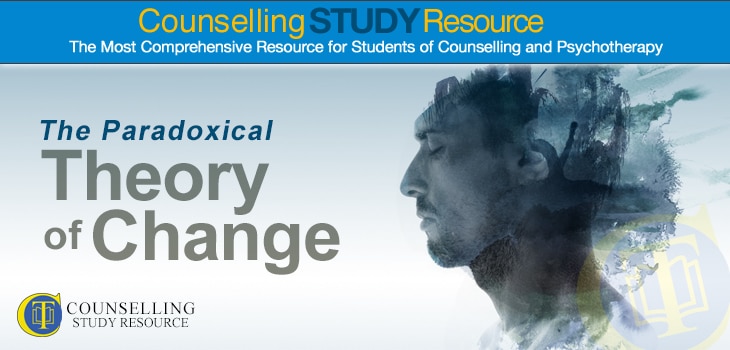Background
The paradoxical theory of change is part of Gestalt therapy, developed by Laura and Friedrich (‘Fritz’) Perls in the 1940s and 1950s. Feltham and Dryden (1993: 75) define it as ‘a distinctive method of counselling and therapy … which emphasises immediacy, experiencing and personal responsibility’.
Gestalt therapy examines the integrated experiences of clients and relationships with society. Gestalt therapy focuses on the process (i.e. what is happening) rather than on the content (i.e. what is being discussed). The goal is for clients to be aware of what they are doing and how, and so to identify how they can learn to accept themselves and/or change. Worsley (2012: 174) writes: ‘Gestalt’s genius has been to describe human awareness in detail and systematically. This description differs from [Carl] Rogers’, but has much in common with person-centred theory.’ Both approaches are based on phenomenology.
What Is the Paradoxical Theory of Change?
This theory can be summarised as: change happens when a person becomes what they are, not when they try to become what they are not. In other words, we can’t make ourselves or anyone change in line with some ideal, but we will naturally change in an organic, meaningful and orderly way if we only allow ourselves and others to be as we and they truly are.
Application in Therapy

In line with this, the Gestalt therapist rejects the role of being a change agent, strongly encouraging the client to be where and what they are. The underpinning idea is that it is very difficult to move if we do not start from a position of sure footing, and that that place comes best from allowing ourselves to be our real selves. A client who comes for therapy is constantly moving between what they feel they should be and what they feel they really are. The Gestalt therapist asks the client to put themselves fully into one role or the other at any particular time, encouraging acceptance of both – and thus a return to the natural state of wholeness. For example, ‘clients are often encouraged to engage in dialogues between one part of themselves and another, the aim being to clarify incomplete understanding and to enable integration’ (Feltham and Dryden, 1993: 75).
Gestalt therapists believe that if the therapist tries actively to change the client, this establishes an unhealthy situation of the therapist being ‘top dog’ and the client ‘under-dog’, which is a microcosm of the situation within the client (that is, the constant battle between what they think they are and what they think they ought to be). Instead, the client needs to fully experience themselves in the moment. This is in keeping with Marcel Proust’s saying ‘We are healed of a suffering only by experiencing it to the full.’
Wider Application
Proponents of the Gestalt approach assert that it is well suited to the modern world as this is constantly changing. Thus, having the ability to find stability through being flexible and adaptive helps people to ‘move with the times’. Gestalt therapists argue that the paradoxical theory of change can apply to society as a whole rather than just to the individuals that comprise it, encouraging integration rather than compartmentalisation of different population groups. The idea here is that societal change is a macrocosm of individual change.
Seligman (2006: 234) writes that ‘research suggests that it [Gestalt therapy] does have broad application, perhaps even broader than Fritz and Laura Perls originally anticipated’.
Examples
‘Gestalt therapy seems well suited to a diverse range of clients’ (Seligman, 2006: 235). The paradoxical theory of change could be seen as applying to various client situations, for example:
- a bereaved client who does not wish to feel grief and therefore is resisting this experience
- a client who won’t allow themselves to be angry and so is again resisting experiencing this feeling.
Free Handout Download
The Paradoxical Theory of Change
References
Feltham C and Dryden W (1993) Dictionary of Counselling, Whurr Publishers
Seligman L (2006) Theories of Counseling and Psychotherapy, Pearson
Worsley R (2012) ‘Integrating with Integrity’, in Sanders P (2012) The Tribes of the Person-Centred Nation, PCCS Books, 161–186
